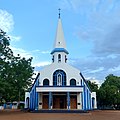Sivaganga
Sivaganga is the headquarters of the Sivaganga district in the South Indian state of Tamil Nadu. It is also the headquarters of the Sivaganga taluk. The town is located at a distance of 48 km (30 mi) from Madurai and 449 km (279 mi) from the state capital Chennai.It is the important city in this district for official and commercial purpose.
Sivagangai kingdom was founded by Sasivarna Periya Oodaya Thevar in 1730. The town was subsequently ruled by his successors and ultimately by Velu Nachiyar under the stewardship of Maruthu Pandiyar. They were against the British Empire, but ultimately lost to them in 1790. The Company appointed Gowry Vallaba Periya Oodaya Thevar as the Zamindar of Sivaganga in 1801, whose successors continued with chaos until India's independence in 1947. It was under Ramnad district until 1984 and subsequently a part of the newly formed Sivaganga district. The town is known for agriculture, metal working and weaving. The region around Sivaganga has considerable mineral deposits.
Sivaganga is administered by a municipality established in 1965. As of 2011, the municipality covered an area of 6.97 km2 (2.69 sq mi) and had a population of 40,403. Sivagangai comes under the Sivaganga assembly constituency which elects a member to the Tamil Nadu Legislative Assembly once every five years and it is a part of the Sivaganga constituency which elects its Member of Parliament (MP) once in five years. Roadways are the major mode of transportation to the town and it also has rail connectivity. The nearest seaport, Thoothukudi Port, is located 189 km (117 mi) from Sivaganga, while the nearest airport, Madurai International Airport, is located 53 km (33 mi) from the town.
Demographics
| Religious census | ||||
|---|---|---|---|---|
| Religion | Percent(%) | |||
| Hindu | 84.75% | |||
| Muslim | 10.07% | |||
| Christian | 4.66% | |||
| Sikh | 0.02% | |||
| Buddhist | 0.01% | |||
| Other | 0.49% | |||
| Historical population | ||
|---|---|---|
| Year | Population | ±% |
| 1961 | 15,642 | — |
| 1971 | 20,826 | +33.1% |
| 1981 | 24,832 | +19.2% |
| 1991 | 33,190 | +33.7% |
| 2001 | 40,220 | +21.2% |
| Sources: | ||
According to 2011 census, Sivaganga had a population of 40,403 with a sex-ratio of 990 females for every 1,000 males, much above the national average of 929.[1] A total of 3,880 were under the age of six, constituting 1,985 males and 1,895 females. Scheduled Castes and Scheduled Tribes accounted for 9.59% and .07% of the population respectively. The average literacy of the town was 83.86%, compared to the national average of 72.99%.[1] The town had a total of 10184 households. There were a total of 14,145 workers, comprising 164 cultivators, 294 main agricultural labourers, 246 in house hold industries, 11,406 other workers, 2,035 marginal workers, 54 marginal cultivators, 127 marginal agricultural labourers, 173 marginal workers in household industries and 1,681 other marginal workers.[2] Sivaganga town had a growth of 25% during the decades of 1991 and 2001. The population density of the town has nearly doubled in the decades of 1981, 1991 and 2001. Spread over area of 6.970 km2 (697.0 ha), the density increased from 3500 person per km2 in 1981 and to 4800 person per km2 in 1991. The development was largely concentrated along the whole town area.[3]
As per the religious census of 2011, Sivaganga had 84.75% Hindus, 10.07% Muslims, 4.66% Christians, 0.02% Sikhs, 0.01% Buddhists and 0.49% following other religions.[4]
Sivaganga Media
References
- ↑ 1.0 1.1 "Census Info 2011 Final population totals". Office of The Registrar General and Census Commissioner, Ministry of Home Affairs, Government of India. 2013. Retrieved 26 January 2014.
- ↑ "Census Info 2011 Final population totals - Sivaganga". Office of The Registrar General and Census Commissioner, Ministry of Home Affairs, Government of India. 2013. Retrieved 26 January 2014.
- ↑ Sivagangai Municipality, Commissioner. "Sivagangai Population details". Sivaganga Municipality. Archived from the original on 17 February 2013. Retrieved 31 Dec 2012.
- ↑ "Population By Religious Community - Tamil Nadu" (XLS). Office of The Registrar General and Census Commissioner, Ministry of Home Affairs, Government of India. 2011. Retrieved 13 September 2015.
Other sources
- Iyer, K. Annasawmi (1899). The Sivaganga Zemindary: Its Origin and Its Litigation 1730 to 1899, with a Genealogical Tree. Hoe & Company, Printers.
- MSME Development Institute. Brief Industrial profile of Sivaganga district (PDF) (Report). Chennai: Ministry of MSME, Government of India. Archived from the original (PDF) on 2017-03-29. Retrieved 2017-09-26.







